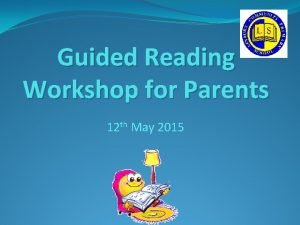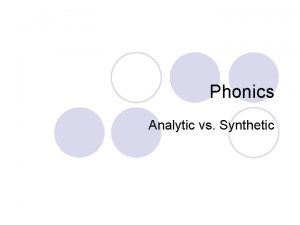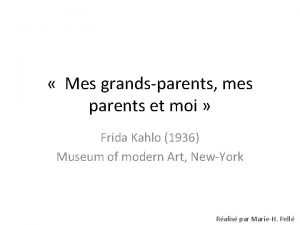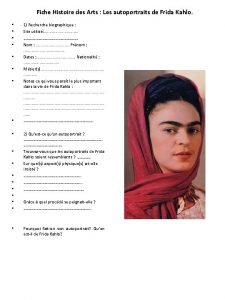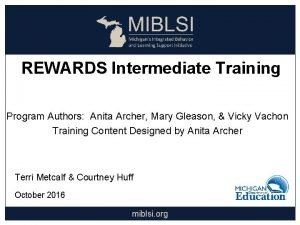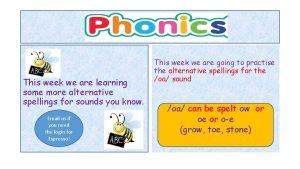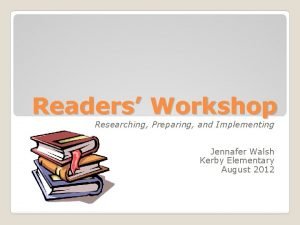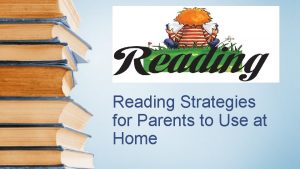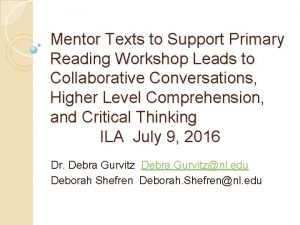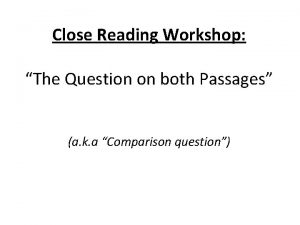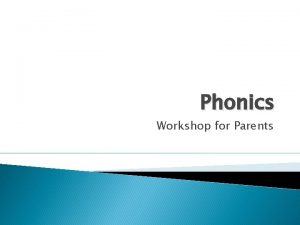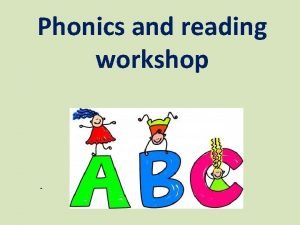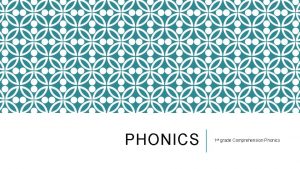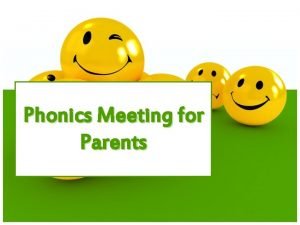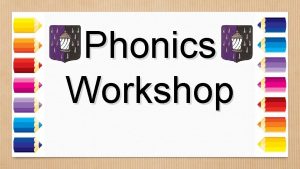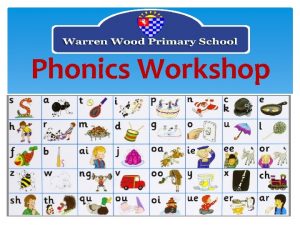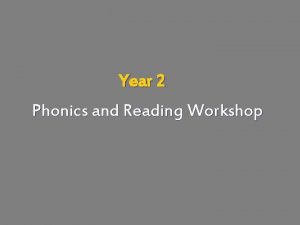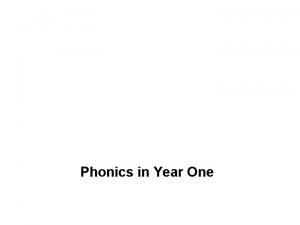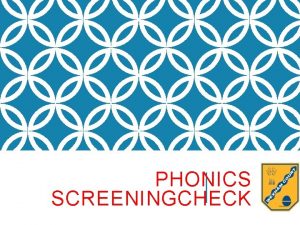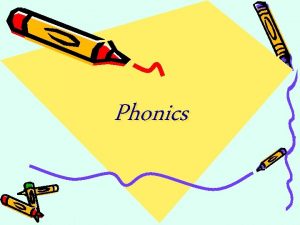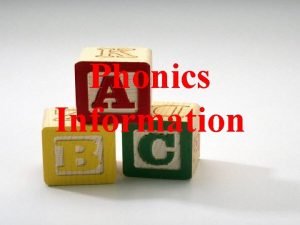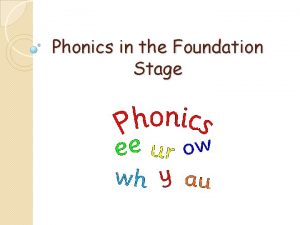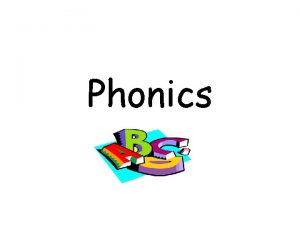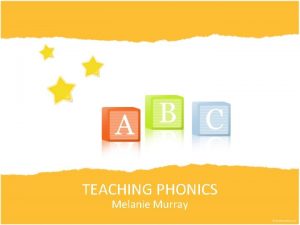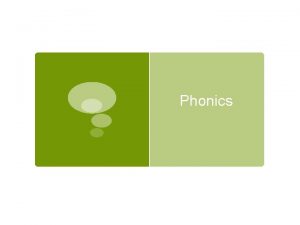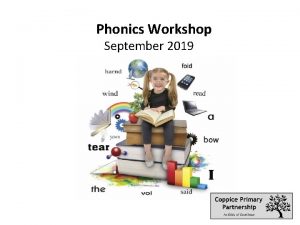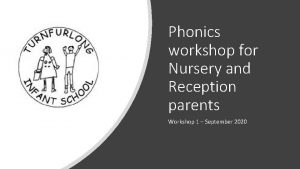Phonics and Reading Workshop for Parents Phonics at

































- Slides: 33

Phonics and Reading Workshop for Parents

Phonics at Western Road � We use Letters and Sounds, which is a national publication written by the DFe. S. It is the advised programme for the teaching of synthetic phonics in England. We use this to follow the order of introducing new sounds, high frequency words and tricky words.

m

l

f

s

t

There approximately 44 single sounds in the English language Consonant b (c k ck) d f g h j l m n p r s t v w x(k/s)y z Consonant digraphs qu ng nk zh ch sh th (unvoiced) th (voiced) vowels a ai e ee i ie or ue oo (little) oo (long) oi ow er air ar ur or ear ure

Blending � Blending the correct sounds will help your child to read. M(uh) + A + T(uh) = Muhatuh M + A + T = MAT

Combinations of Letters � Sounds can be represented by one or more letter Diagraph shop � The same sound can be represented in more than one way Bee key quay Be lady Brief phoenix Bleat receive

Segmenting and Blending Tricky Words � Segmenting is chopping up a word – The skill used to write � Blending is putting the sounds together – The skill used in reading � Tricky words are so called because they are irregular and can’t be segmented or blended.

Finger Twister

Bingo

Magnetic letters

How you can support your child in phonics � Singing � Rhyming � Reading to them � I spy � Spotting words and sounds in book and the environment � Finding out what they have been learning and get them to show you how clever they are! Ask them to explain things to you.

Letters and Sounds � Broken down in to 6 Phases. � Phase 1 – Nursery and Reception � Phase 2 – Reception � Phase 3 – Reception � Phase 4 – Reception/Year 1 � Phase 5 – Year 1 � Phase 6 (Support for Spelling) – Year 2

Phase 1 Phase One of Letters and Sounds concentrates on developing children's speaking and listening skills and lays the foundations for the phonic work which starts in Phase 2. The emphasis during Phase 1 is to get children attuned to the sounds around them and ready to begin developing oral blending and segmenting skills.

Phase 2 � In Phase 2, letters and their sounds are introduced one at a time. A set of letters is taught each week, in the following sequence: � Set 1: s, a, t, p Set 2: i, n, m, d Set 3: g, o, c, k Set 4: ck, e, u, r Set 5: h, b, f, ff, l, ll, ss � The children will begin to learn to blend and segment to begin reading and spelling. This will begin with simple words.

Terminology � Phoneme - It is the smallest unit of sound a piece of terminology that children like to use and should be taught. � Blend - Blending is the process that is involved in bringing the sounds together to make a word and is how /c/ /a/ /t / becomes cat. � Segment – Chopping up the word into their sounds

Phase 3 � By the time they reach Phase 3, children will already be able to blend and segment words containing the 19 letters taught in Phase 2. � Over the twelve weeks which Phase 3 is expected to last, twenty-five new graphemes are introduced (one at a time). � Set 6: j, v, w, x � Set 7: y, z, zz, qu � Consonant digraphs: ch, sh, th, ng � Vowel digraphs: ai, ee, igh, oa, oo, ar, or, ur, ow, oi, ear, air, ure, er

Phase 4 � By Phase 4 children will be able to represent each of 44 phonemes with a graphemes. They will blend phonemes to read CVC words and segment CVC words for spelling. They will also be able to read two syllable words that are simple. They will be able to read all the tricky words learnt so far and will be able to spell some of them. � This phase consolidates all the children have learnt in the previous phases.

Phase 5 � Children will be taught new graphemes and alternative pronunciations for these graphemes and graphemes they already know. They will begin to learn to choose the appropriate grapheme when spelling. ay day ou out ie tie ea eat oy boy ir girl ue blue aw saw wh when ph photo ew new oe toe au Paul a-e make e-e these i-e like o-e home u-e rule

Phase 6 � In phase 6, the focus is on learning spelling rules for word endings or suffixes. � They will learn how words change when you add certain letters. There are 12 different suffixes taught: -s -er -ful -est -ly -ing -y -ment -ness -ed -en


• Every Year 1 child in the country will be taking the phonics screening check in the same week in June. • The aim of the check is to ensure that all children are able to read by the end of year two. • This ‘midpoint check’ will ensure that we have a clear understanding of what the children need to learn in year 2.

• The check is very similar to tasks the children already complete during phonics lessons. • Children will be asked to ‘sound out’ a word and blend the sounds together. eg d-o-g - dog • The focus of the check is to see which sounds the children know and therefore the children will be asked to read made up ‘nonsense’ words. THIS IS NOT A READING TEST.


• The screening will take place throughout the week beginning Monday 12 th June 2017. The children cannot retake the test at any other time so it is very important your child is in school during this week. • The check has been designed so that children of all abilities will be able to take part.

• The children will complete the check one at a time in a quiet area of the school. • Miss Mackinnon will conduct all of the screening checks with the children in Year 1. • The screening will only take 10 – 15 mins with each child.

• Encourage your child to ‘sound out’ when reading or writing. Focusing particularly on spotting more unusual sound patterns. Eg Digraph- 2 letters making one sound cow Trigraphs- 3 letters making one sound night Split digraphs- 2 vowels with a consonant in between. spine - i_e

• REMEMBER: Phonics is not the only thing needed to become a fluent reader. • Please continue to read with your child every day and encourage them to: • Sound out • Re-read to check it makes sense. • Use pictures for clues. • Ask questions about the book. • And most importantly ENJOY READING!

What do early readers have to do? � Point to the words to match what is read to the words in the print � Use phonic skills – sound out and blend the sounds in new words � Think about what would make sense, perhaps by checking the picture and then checking the word to see if it looks right

 Reading workshop for parents
Reading workshop for parents Synthetic phonics vs analytic phonics
Synthetic phonics vs analytic phonics While reading activities
While reading activities Frida kahlo grands parents
Frida kahlo grands parents Parents parents
Parents parents Fiche frida kahlo
Fiche frida kahlo Phonics for reading anita archer
Phonics for reading anita archer Ash's phonics
Ash's phonics Pros and cons of reading workshop
Pros and cons of reading workshop Reading strategies for parents
Reading strategies for parents Mentor texts for reading workshop
Mentor texts for reading workshop The authors of both passages agree that
The authors of both passages agree that Aims of teaching
Aims of teaching While reading stage
While reading stage Intensive reading and extensive reading
Intensive reading and extensive reading What is intensive reading
What is intensive reading Style of reading
Style of reading Kontinuitetshantering
Kontinuitetshantering Novell typiska drag
Novell typiska drag Nationell inriktning för artificiell intelligens
Nationell inriktning för artificiell intelligens Vad står k.r.å.k.a.n för
Vad står k.r.å.k.a.n för Varför kallas perioden 1918-1939 för mellankrigstiden?
Varför kallas perioden 1918-1939 för mellankrigstiden? En lathund för arbete med kontinuitetshantering
En lathund för arbete med kontinuitetshantering Adressändring ideell förening
Adressändring ideell förening Personlig tidbok fylla i
Personlig tidbok fylla i Sura för anatom
Sura för anatom Densitet vatten
Densitet vatten Datorkunskap för nybörjare
Datorkunskap för nybörjare Stig kerman
Stig kerman Mall debattartikel
Mall debattartikel Autokratiskt ledarskap
Autokratiskt ledarskap Nyckelkompetenser för livslångt lärande
Nyckelkompetenser för livslångt lärande Påbyggnader för flakfordon
Påbyggnader för flakfordon Arkimedes princip formel
Arkimedes princip formel
